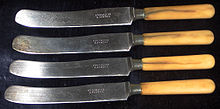



A table knife is an item of cutlery with a single cutting edge, and a blunt end – part of a table setting. Table knives are typically of moderate sharpness only, designed to cut prepared and cooked food.




A table knife is an item of cutlery with a single cutting edge, and a blunt end – part of a table setting. Table knives are typically of moderate sharpness only, designed to cut prepared and cooked food.
In early periods in the West, no special kind of knife was used at the table. Men and often women from all classes carried a knife around with them for a great variety of tasks, from pruning trees to personal protection or eating at table. The Anglo-Saxon and Germanic version of this was called the seax , often over a foot long. The original table knife was invented by Cardinal Richelieu. Guests at a meal brought their own cutlery, usually in a little case called a cadena. It was only in the 17th century that hosts among the elite again began to lay out cutlery at the table, [1] although at an Italian banquet in 1536 for Charles V, Holy Roman Emperor, it is recorded that each guest was provided with knife, spoon and fork, evidently a rarity. [2]
The distinguishing feature of a table knife is a blunt or rounded end. The origin of this, and thus of the table knife itself, is attributed by tradition to Cardinal Richelieu around 1637, reputedly to cure dinner guests of the habit of picking their teeth with their knife-points. [3]
Later, in 1669, King Louis XIV of France banned all pointed knives in his Flemish provinces, insisting on blunt tips, in the hope that it would reduce knife crime. [4] [5] [6]
In any table setting, the knife will typically be the piece to bear the maker's stamp on the blade. The English city of Sheffield is noted for its cutlery manufacture and many knives bear the city's name in addition to the maker's.
In the past the blades were typically of carbon and/or stainless steel, with handles of bone, wood, or ivory, but many modern examples are now made from a single piece of stainless steel for both handle and blade as per the example pictured.

A special type of a table knife is a knife with a "Buckels" blade. [7] It is also called "Old German table knife". These blades are usually very thin ground and additionally made of carbon steel. As a result, these blades are extremely sharp and it is not necessary to use an additional knife with a serrated edge to cut bread or buns.
In the past a large type of table knife may have been referred to as a "case knife". These knives were stored in cases, and were also known as sheath knives. [8]
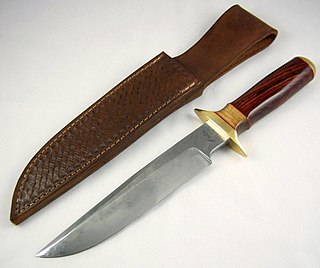
A knife is a tool or weapon with a cutting edge or blade, usually attached to a handle or hilt. One of the earliest tools used by humanity, knives appeared at least 2.5 million years ago, as evidenced by the Oldowan tools. Originally made of wood, bone, and stone, over the centuries, in step with improvements in both metallurgy and manufacturing, knife blades have been made from copper, bronze, iron, steel, ceramic, and titanium. Most modern knives have either fixed or folding blades; blade patterns and styles vary by maker and country of origin.
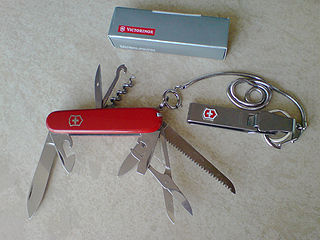
The Swiss Army knife is a pocketknife, generally multi-tooled, now manufactured by Victorinox. The term "Swiss Army knife" was coined by American soldiers after World War II because they had trouble pronouncing the German word "Offiziersmesser", meaning "officer’s knife".

A blade is the sharp, cutting portion of a tool, weapon, or machine, specifically designed to puncture, chop, slice, or scrape surfaces or materials. Blades are typically made from materials that are harder than those they are intended to cut. This includes early examples made from flaked stones like flint or obsidian, evolving through the ages into metal forms like copper, bronze, and iron, and culminating in modern versions made from steel or ceramics. Serving as one of humanity's oldest tools, blades continue to have wide-ranging applications, including in combat, cooking, and various other everyday and specialized tasks.
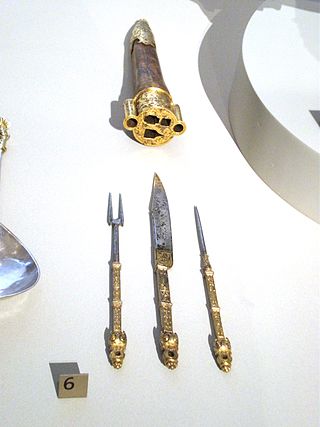
Cutlery includes any hand implement used in preparing, serving, and especially eating food in Western culture. A person who makes or sells cutlery is called a cutler. While most cutlers were historically men, women could be cutlers too; Agnes Cotiller was working as a cutler in London in 1346, and training a woman apprentice, known as Juseana.

A Japanese kitchen knife is a type of kitchen knife used for food preparation. These knives come in many different varieties and are often made using traditional Japanese blacksmithing techniques. They can be made from stainless steel, or hagane, which is the same kind of steel used to make Japanese swords. Most knives are referred to as hōchō or the variation -bōchō in compound words but can have other names including -kiri. There are four general categories used to distinguish the Japanese knife designs: handle ; blade grind ; steel ; and construction.

Yanagi-ba-bōchō, Yanagiba, or yanagi, is a long and thin knife used in the Japanese cuisine. It is the typical example of the sashimibōchō used to slice fish for sashimi and nigirizushi.
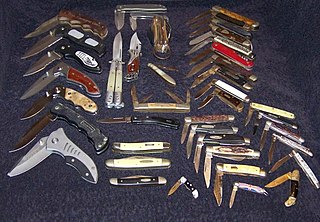
A pocketknife is a knife with one or more blades that fold into the handle. They are also known as jackknives, folding knives, EDC knife, or may be referred to as a penknife, though a penknife may also be a specific kind of pocketknife. A typical blade length is 5 to 15 centimetres.
The Laguiole knife is a traditional Occitan pocketknife originally produced in the "knife city" of Thiers, source of 70% of France's cutting tool production, as well as the small village of Laguiole, both located in the Massif Central region of France. Laguiole in this instance does not refer to any knife brand in France, where use of the name is not legally restricted, but to a generic type of traditional slipjoint knife of a sort associated with this French region, now made worldwide.

A kitchen knife is any knife that is intended to be used in food preparation. While much of this work can be accomplished with a few general-purpose knives — notably a large chef's knife and a smaller serrated blade utility knife — there are also many specialized knives that are designed for specific tasks such as a tough cleaver, a small paring knife, and a bread knife. Kitchen knives can be made from several different materials, though the commonest is a hardened steel blade with a wooden handle.
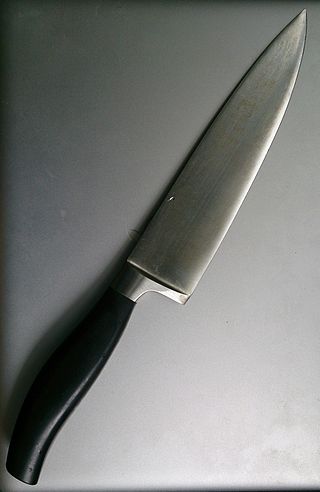
In cooking, a chef's knife, also known as a cook's knife, is a cutting tool used in food preparation. The chef's knife was originally designed primarily to slice and disjoint large cuts of beef and mutton. Today it is the primary general food preparation knife for most Western cooks.
Spyderco is an American cutlery company based in Golden, Colorado, producing knives and knife sharpeners. Spyderco pioneered many features that are now common in folding knives, including the pocket clip, serrations, and the opening hole. Spyderco has collaborated with 30 custom knife makers, athletes, and self-defense instructors for designs and innovated the usage of 20 different blade materials.

Sharpening is the process of creating or refining a blade, the edge joining two non-coplanar faces into a converging apex, thereby creating an edge of appropriate shape on a tool or implement designed for cutting. Improving sharpness is done by removing material on an implement with an abrasive substance harder than the material of the implement, followed sometimes by processes to polish/hone the sharp surface to increase smoothness.

A ceramic knife is a knife with a ceramic blade typically made from zirconium dioxide (ZrO2; also known as zirconia), rather than the steel used for most knives. Ceramic knife blades are usually produced through the dry-pressing and firing of powdered zirconia using solid-state sintering. The blades typically score 8.5 on the Mohs scale of mineral hardness, compared to 4.5 for normal steel and 7.5 to 8 for hardened steel and 10 for diamond. The resultant blade has a hard edge that stays sharp for much longer than conventional steel blades. However, the blade is brittle, subject to chipping, and will break rather than flex if twisted. The ceramic blade is sharpened by grinding the edges with a diamond-dust-coated grinding wheel.

A mora knife is a small sheath knife. It is a fixed blade knife, with or without a finger guard. The term originates from knives manufactured by the cutleries in Mora, Dalarna, Sweden. In Sweden and Finland, Mora knives are extensively used in construction and in industry as general-purpose tools. Mora knives are also used by all Scandinavian armies as an everyday knife.

W.R. Case & Sons Cutlery Company is an American manufacturer of traditional pocket knives, fixed blades/sporting knives, kitchen knives, limited edition commemoratives and collectibles. The company originated in Little Valley, New York, around the turn of the 20th century, before relocating to its current home, Bradford, Pennsylvania, in 1905. The company's namesake, William Russell Case, first made knives with his brothers under the name Case Brothers Cutlery Company. His son, John Russell ("Russ") Case, worked as a salesman for his father's company before founding W.R. Case & Sons.

SHARPFINGER is a brand of knife modeled after the Schrade 152 OT. The SHARPFINGER trademark is designated to a variety of knives in this design by a number of makers.

A grapefruit knife is a special type of knife designed specifically for cutting grapefruit. Grapefruit knives are small with a curved serrated blade, designed to hug the curves of the grapefruit. This is used to separate the outer edge of the segments from the rim of the fruit. The term "grapefruit knife" can refer to a type of knife with short, serrated twin blades about 2mm apart, used to separate the sides of each section from the dividing membrane. Some grapefruit knives incorporate both types, a double-sided curved blade on one side and the parallel twin blades on the other. Another type includes an angled tip and double sided serrated blade. When both types are used, the result is an intact-looking fruit with sections which lift out easily - especially if a "grapefruit spoon" is used.
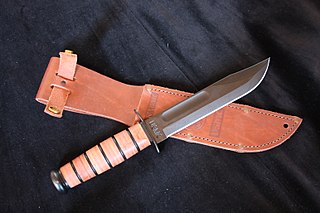
Ka-Bar is the contemporary popular name for the combat knife first adopted by the United States Marine Corps in November 1942 as the 1219C2 combat knife, and subsequently adopted by the United States Navy as the U.S. Navy utility knife, Mark 2. Ka-Bar is the name of a related knife manufacturing company, Ka-Bar Knives., Inc., of Olean, New York, a subsidiary of the Cutco Corporation.

A steak knife is a sharp table knife designed to efficiently and effectively cut steak. This type of knife comes in a variety of styles and sizes; however, the design often used in a steakhouse typically features a partially serrated blade and wood handle.